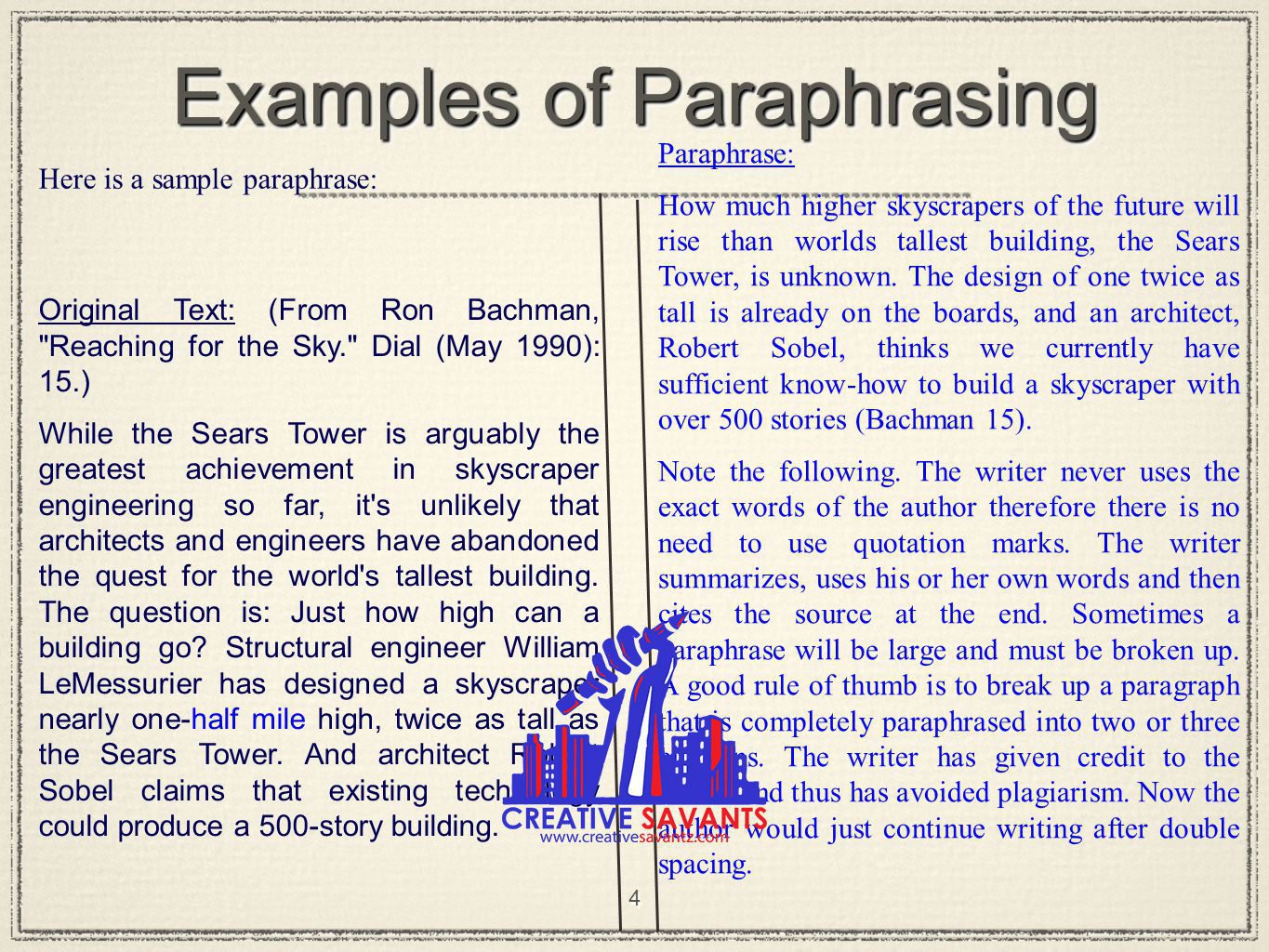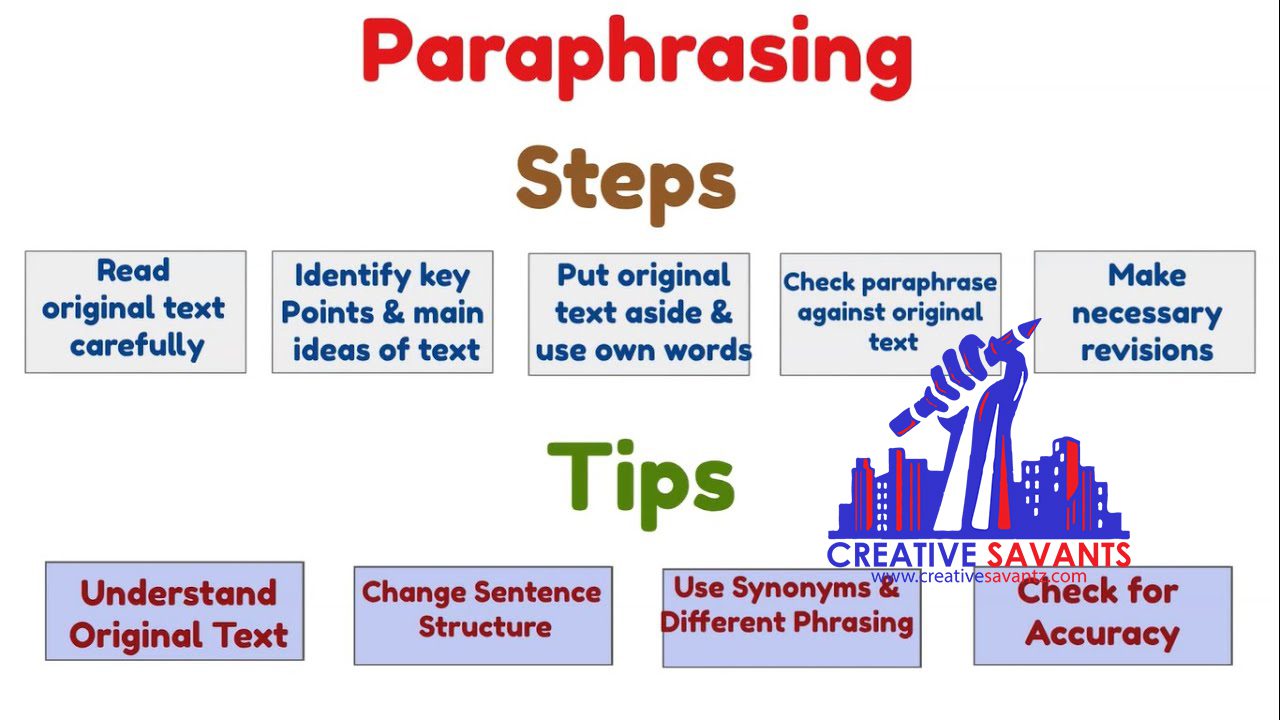In today’s digital age, effective communication is critical. Whether you’re a student, a professional writer, or someone who regularly engages with written content, conveying ideas clearly and accurately is paramount. Imagine having the ability to transform a dry, uninteresting piece of writing into a captivating masterpiece. Paraphrasing techniques can make it happen.
Read More: Sophia Learning Platform: Get Full Online Assistance for your Sophia Courses- March 2023
Paraphrasing is a skill that students and writers must master to convey information while maintaining the originality of their work effectively. Don’t let the fear of plagiarism hinder your creativity and productivity.
What is Paraphrasing?
Paraphrasing is like giving a fresh makeover to someone else’s ideas, story, or explanation while still capturing the main message. It’s a valuable skill with many purposes. The primary goal of paraphrasing is to summarize a passage, either to make it more concise or to clarify the information it contains. However, some people get confused between summarizing and paraphrasing, even though they’re slightly different.
Paraphrasing can be considered an essential part of summarizing, but it has a unique purpose. When summarizing, you shorten the original text, condensing it to the most essential points. On the other hand, the paraphrasing technique involves changing the words themselves while retaining the overall meaning.

How to Paraphrase a Paragraph
Paraphrasing a paragraph requires a clear understanding of the main ideas and supporting details. To paraphrase effectively, follow these paraphrasing techniques and steps:
Understand the main idea
Read the paragraph thoroughly and identify the key message or argument it conveys. This will serve as the foundation for your paraphrase.
Use different sentence structures
Rewrite the sentences in the paragraph using alternative structures. Change the order of words, convert statements into questions, or transform passive voice into active voice. These variations will help create a fresh and engaging paraphrase.
Read More: Straighterline Help: Get Straighterline Final Exam Answers- March 2023
Maintain coherence and flow
Ensure that your paraphrase maintains a logical flow and coherence. Connect ideas smoothly and transition between sentences and paragraphs seamlessly.
Review and revise
Once you’ve completed your paraphrase, read it aloud and compare it to the original paragraph. Make any necessary adjustments to improve clarity, accuracy, and overall effectiveness.
Examples of Paraphrasing
To illustrate an effective paraphrasing technique, consider the following original sentence:
Original: “The internet has revolutionized communication by enabling people to connect instantly globally.”
Paraphrased: “In this digital age, the internet has completely transformed how individuals from different parts of the world can effortlessly communicate with each other.”
Get Your Quote NowHere’s another example:
Original: “The scientific discovery has significantly advanced our understanding of the universe.”
Paraphrased: “This mind-blowing scientific discovery has taken our knowledge of the universe to a whole new level. It’s like a giant leap forward in understanding the mysteries of space and everything beyond.
Another one
Original Sentence: “The rise of social media has revolutionized how people communicate and share information.”
Paraphrased Sentence: “Social media has completely transformed the methods of communication and information exchange.

Do’s of Paraphrasing
Understand the Original content
Regarding paraphrasing, there’s one golden rule you should always follow: dive deep into the original text. By fully understanding the original text, you lay a solid foundation for creating a paraphrased version that captures the essence of the original. This means that your reworded text will convey the same ideas and concepts, maintaining the integrity of the original author’s message. You can express the same ideas in various styles while ensuring precision and accuracy in your paraphrased content.
Read More: An Ultimate Guide to get D2L Brightspace Learning Help and Homework Assistance
The result? Readers who engage with your paraphrased text will quickly grasp the communicated ideas. Your ability to encapsulate the original message freshly and engagingly opens up new avenues for adequate comprehension. Trust Creative Savants to understand the original text entirely so your ideas shine brighter than ever before.

Do Focus on the Main Ideas
Identify the main ideas and arguments presented in the original text. Instead of paraphrasing every sentence, concentrate on capturing and conveying these key concepts effectively. This will help you maintain coherence and conciseness in your paraphrase.
Do Combine Sentences
The paraphrasing technique allows you to condense information and present it more concisely. Look for opportunities to combine sentences or phrases while retaining the essence of the content. However, be careful to keep all essential details and the intended meaning.
Do Cite Your Sources
Whenever you paraphrase information that is not common knowledge, make sure to cite your sources correctly. Even though you are expressing the ideas in your own words, acknowledging the original author’s contribution is essential for academic integrity and to avoid plagiarism.

Omitting or Adding Information
Paraphrasing technique does not mean leaving out or inserting information at will. Your paraphrase should encompass the essential elements of the original text while presenting them in a new way. Avoid cherry-picking information or including your own ideas that were not present in the source material. Stay true to the original content while putting it into your own words.
Read More: Get Reliable FLVS Answer keys and Online Help- March 2023
Don’ts of Paraphrasing
Remember to review and polish your paraphrased work before you hand it in. It’s crucial to double-check for plagiarism and any other quality concerns. Check for inconsistencies, awkward phrasing, or accidental changes to the original meaning. Read your paraphrase aloud to ensure its clarity and coherence. This final step is crucial to ensure your paraphrase is accurate and effectively conveys the intended message.
Ignoring Style and Tone Consistency
When paraphrasing, maintain consistency in style and tone with the rest of your writing. Adapt the paraphrased content to fit seamlessly with the overall flow of your piece. Avoid abrupt shifts in style or tone, as it can disrupt the reader’s experience and create confusion. Aim for a cohesive and harmonious blend of your voice and the original author’s ideas.
Overusing Quotations
Paraphrasing is meant to demonstrate your understanding and interpretation of the source material, not to rely heavily on direct quotations. While occasional quotes can be helpful in emphasizing key points, excessive use can make your writing appear lazy or lacking in originality. Strive to paraphrase the majority of the content and use quotations sparingly.
Patchwriting
Patchwriting involves copying and pasting phrases or sentences from the original source with minor alterations. It is a form of plagiarism and should be strictly avoided. Always aim to present the ideas in your own words, using proper citations when necessary.
Read more: SNHU Answers: Get SNHU Online Assistance from Experts- March 2023
Neglecting Paraphrasing Techniques and Tools
Numerous paraphrasing techniques and tools available can assist you in the process. Use online paraphrasing tools or employ techniques such as changing sentence structure, synonyms, and incorporating different sentence types. However, be cautious when using automated tools as they may not always provide accurate results. Always double-check the output to ensure it aligns with your intended meaning.

How to rephrase a sentence
Want to know how to rephrase a sentence? It’s all about expressing the same idea using different words and sentence structures. Don’t worry, I’ve got some techniques that will help you rephrase like a pro:
- Get friendly with synonyms and antonyms: Swap out words with similar or opposite meanings to give your sentence a fresh twist.
- Shake up the sentence structure: Switch between active and passive voice, or vice versa, to change things up and add variety.
- Play with sentence order: Rearrange the words to create a new flow and make your sentence more engaging.
- Keep it simple: Break down complex sentences into shorter ones. It makes your writing more straightforward and adds a touch of elegance.
Looking For The Reliable Solutions?
Example
Original Sentence: “He decided to pursue a career in medicine.”
Rephrased Sentence: “He chose to embark on a medical career.”
Paraphrasing mistakes and Paraphrasing errors

There are several common mistakes writers often make when attempting to paraphrase, which can compromise the clarity and integrity of their work. By understanding and avoiding these paraphrasing errors, you can ensure that your writing remains authentic and effective.
- Changing only a few words from the original without altering the sentence structure.
- Using synonyms that do not accurately convey the intended meaning.
- Failing to cite the source or attribute the ideas to the original author.
- Paraphrasing excessively or unnecessarily dilutes the clarity of the text.
- Incorrectly changing sentence structure.
- Overusing quotations.
- Not reviewing and revise.
- leaving out or inserting information at will
Avoiding these paraphrasing errors requires careful attention to detail, a comprehensive understanding of the source material, and a commitment to maintaining the integrity of the original message. By honing your paraphrasing skills and applying the techniques correctly, you can transform your writing into a compelling and authentic expression of ideas.
Paraphrased Quotes
Paraphrased quotes involve restating a direct quote from a source in your own words. It is crucial to accurately convey the original meaning while avoiding quotation marks. Paraphrased quotes provide an opportunity to integrate source material smoothly into your writing.
Read More: An Overview About Blackboard service: Get Blackboard Help- February 2023
Quoting vs. paraphrasing
Knowing when to quote and when to paraphrase is important. Quoting is like using the author’s exact words, which is great when those words are important or have a lot of meaning. It’s like giving credit to the author for their powerful words. On the other hand, paraphrasing is like using your own words to capture the main ideas of a big chunk of text. It’s handy when you want to summarize much information without getting into the nitty-gritty details of the original wording. Quote and paraphrasing have their place in writing, and understanding when to use each can make your writing more effective and engaging.

Paraphrasing tools
Paraphrasing tools are designed to assist in rewording and restructuring sentences to create unique content. They can be a great resource for students, writers, and anyone seeking to enhance their writing. Paraphrasing tools analyze the input text and offer alternative wordings and sentence structures. However, it’s essential to exercise caution when using paraphrasing tools. While they can be beneficial, they are not infallible. Automated tools often produce inaccurate or incoherent paraphrases, which can lead to misleading or plagiarized content. By using the tool as a starting point and then refining the output through manual editing, you can ensure the final result is clear, coherent, and unique.
Paraphrasing Guidelines
To summarize, follow these guidelines for effective paraphrasing techniques:
- Understand the source material thoroughly.
- Use your own words and sentence structures.
- Maintain the original meaning.
- Attribute ideas to the original author by citing the source.
- Revise and edit your paraphrased text for clarity and coherence.
Say No to Plagiarism, Say Yes to Creative Savants Company’s Paraphrasing
We understand that writing, whether it’s academic or professional, can be a daunting task for both native and non-native language users. The art of conveying ideas and thoughts with clarity requires practice and precision. At Creative Savants, we recognize the challenges faced by students, researchers, and writers regarding paraphrasing. We aim to alleviate this burden by offering a reliable and efficient paraphrasing service.
Creative Savants Company’s Online Paraphrasing services are your gateway to unlocking your creative potential, improving your writing skills, and maintaining ethical standards. By following the dos and don’ts of paraphrasing, you can produce engaging and unique content while avoiding plagiarism. Don’t settle for mediocrity—embrace the power of effective paraphrasing with Creative Savants’s service today!
Read more: The Dos And Don’ts Of Paraphrasing: A Comprehensive Guide
Conclusion
In the world of writing, paraphrasing is like a delicate dance between creativity and integrity. The paraphrasing technique may seem simple, but it carries significant responsibilities. By adhering to the dos and don’ts of paraphrasing, you can avoid unintentional plagiarism and ensure that your writing reflects your own understanding and interpretation of the original text.
Remember to always use your own words, give credit when necessary, and avoid changing the original text’s meaning. So, approach paraphrasing with care, be diligent in your research, and always provide proper attribution. With these guidelines in mind, you’ll be able to paraphrase effectively and confidently, enhancing the quality of your writing and avoiding any unintentional pitfalls.

